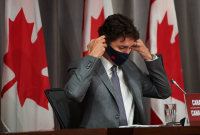Support strong Canadian climate journalism for 2025
Ontario Premier Doug Ford said a “perfect storm” is brewing as back-to-school combines with the flu season and a possible second wave of COVID-19.
Ontario recorded 313 new confirmed infections on Monday, its highest single-day count since early June. After reaching a low of 33 in early August, numbers have been trending higher in recent weeks and have been above 200 per day since Sept. 12.
“This virus is still amongst us,” Ford said during a news conference at the Queen’s Park provincial legislature Monday. “So the only question left is how bad will the second wave be, and the answer to that question, it's up to all of us.”
It was also the first day back at work at Queen’s Park since July 22, meaning the opposition parties will be asking that question of the Progressive Conservatives a lot more directly now.
The spike in cases comes at a sensitive time for Ford and his education minister, Stephen Lecce, with around half a million young people in Toronto and neighbouring Peel (which includes the cities of Mississauga and Brampton) restarting studies this week.
Cases have already shown up in school communities, as well as at a post-secondary institution, although public health officials in London, Ont., say the five Western University students who tested positive on the weekend had not been on campus but had mingled in the city’s bars and restaurants.
Ford and Lecce have been sharply criticized for not spending enough money to ensure adequate physical distancing in classrooms, especially elementary classes, which they left static at pre-pandemic sizes.
Schools and boards have since been collapsing grades together as they collate the intentions of parents to either send their children to school or enrol them in a virtual classroom, which must also be staffed by teachers and other education workers and management.
Lecce said the province has been seeing “the migration of tens of thousands (of students) back and forth” between registering for in-class or online instruction, and that boards have been consolidating classes to make up for the unknown numbers.
Teachers have also been getting assigned to virtual or physical classrooms as per their own health requirements and the needs of their school and board.
The Toronto District School Board postponed the opening of its virtual school until Sept. 22, citing the need for 200 more online classrooms (and online teachers). In a letter to parents it posted Monday the board, Canada's largest with board with almost 250,000 students, said that since last Tuesday its virtual school expanded from around 66,000 students to more than 72,000.
Lecce was asked about teachers who were struggling to safely accommodate up to 33 students and responded by repeating the amounts the provincial government had spent or activated.
“Boards are acting quickly on reducing classroom sizes, supported by provincial investment,” he said. “Over $170 million unlocked, plus the original [$30 million] brings it to $200 million, that alone could hire upwards of 2,000 teachers in this province.”
Those unblocked funds Lecce is referring to are rainy day funds the province is forcing boards to spend to top up provincial efforts. Monies from such contingency accounts are often set aside by boards for long-term projects such as major building renovations. Ottawa has also provided a significant chunk of overall funding for a safe school re-opening, despite education falling under provincial jurisdiction.
Cases have been rising steadily over the last week or so, especially in and around Toronto (as well as in Ottawa), and Ford said health officials in those regions have told him most cases have emerged from social gatherings, which he has described as backyard parties rather than at licensed establishments.
Both Ford and his health minister, Christine Elliott, warned of the second wave — but did not say that it has begun.
“We have seen an increase in cases, obviously, in the last short while, and a disturbing significant increase today,” Elliott said at the same news conference, which was sparsely attended in-person. “So whether this is the start of a second wave or not, it certainly has our attention, and we are dealing with it,” she said.
She said a second wave would be more difficult and complicated to deal with than the first one, because hospitals have less capacity since they've taken in patients who were in long-term care facilities, and are now conducting the surgeries that were earlier postponed.
The Progressive Conservatives say they have clear plans to protect and support Ontario in this next phase of recovery that they will detail shortly.
Elliott said the government has been preparing for three possible COVID-19 scenarios: small surges up and down, more intense peaks and valleys, and a sudden sharp jump in cases.
Morgan Sharp / Local Journalism Initiative / Canada’s National Observer






Comments
would someone, anyone ask Ford why he has not taken the "science recommended" steps of
1. legislate mask wearing provincially
2. legislate 10 paid sick days for every worker
Instead he threatens and bloviates with empty statements like, "I'll come after you". Really? that is the standard of governance we are dealing with?
For Canadians with a memory...........this is the premier who promised that Ontario was 'open for business'. He didn't promise more health care workers, better long term care, or reduced class size. On the contrary, before he was somewhat 'humanized' by the pandemic, he was attacking all those industries......cutting all those sustainable and 'essential' jobs.
Business oriented right wingers believe in foreign investment, economic growth, low taxes and hamstrung government coffers. THEY DO NOT ENDORSE THE CARE GIVING, LOW CARBON ECONOMY......kids, the old and the sick get warehoused......if they're lucky; some subsection of the population, called Entrepreneurs, get the public tax dollars. Airports, mega projects and financial speculations are what fuels our economy.......
Time for kids and their parents to just suck that up and get out there......do life....play the covid lottery.
It's all good, yes???